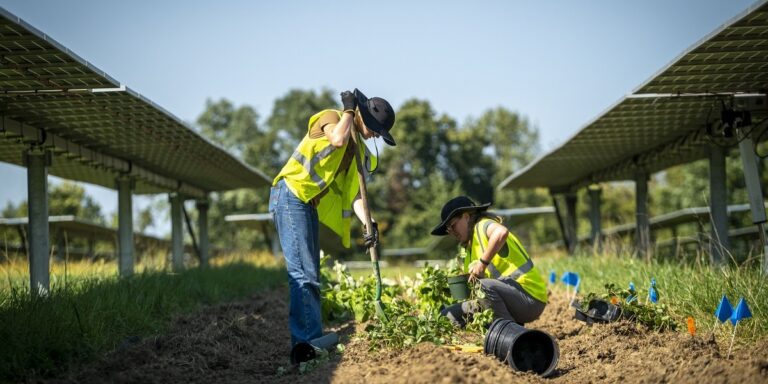Researchers from Cornell University in the US have developed a new optimization model for the design and benefits of the Agrivoltaic site, which was demonstrated using irrigation optimization compared to economic and environmental goals.
Aware of the potential of co-locks of food crops with solar panels and the potential for conflicting objectives of the selection and design of the Agrivoltaic sites, researchers from Cornell University in the United States have developed a new optimization model.
To demonstrate the technology, they have applied it to the solar energy plants of Cornell University and the nearby agricultural experiment stations (AES). The university is located in the US state of New York (NYS) in the northeastern part of the country. The AES contributes to food security, while the projects for solar farms support renewable energy initiatives for the Cornell -Campus, the local community and Nys.
The aim was a case study for site selection and design that gave priority to economic and environmental objectives, while irrigation and retention of water is considering. “An important challenge was to manage conflicting objectives, in particular the balancing of economic profits, environmental benefits and irrigation -efficiency,” Fengqi U, said the accompanying author PV Magazine.
Four models have been developed: two non-linear programs for mixed honest (MINLP) to perform a techno-economic and environmental analysis of co-locking solar PV with crops, independently focused on economic profit or operational emission reductions; and two fractional programming (FP) models to assess the efficiency of water use in relation to economic and environmental goals, as a supplement to standard monetary and emission evaluation tricies.
The fractional format of FP facilitates the analysis without the need for weight coefficients, according to the paper, dealing with multi-objective goals, such as maximizing the yield while irrigation is minimized. They are especially useful when goals differ in units and scales, such as monetary benefit per volume unit.
In order to make the production of crops economically competitive with solar energy, the researchers have assigned an agricultural assessment value (AAV) to improve the crop value and to force minimal arable land restrictions, to ensure productive land use and optimum AGV configurations. In addition, the landrivalent ratio (LER) was used to assess improvements in the efficiency of land use, comparing AGV with traditional practices.
A variety of fixed monocrystalline silicon PV panels, polycrystalline silicon, dual-axis tracking monocrystalline and copper indium gallium donelenide (cigs) thin film technologies were evaluated.
The researchers discovered that prioritizing solar installation in the FP models minimizes the irrigation requirements, but the economic benefits increase as the models allocate more land. They said that “a 90% arable land allocation yields the highest income, ranging from 10.78% to 186.77% ($ 5.86-34.88/m3) and a country quotio of 4.40 reached.”
“The FP environment model suggests restrictive arable land to less than 60% for optimum emission reductions, which reduces the emissions to 54.01-112.18 tons of CO2 EQ/M3, which is lower than emissions of conventional individual crop and tanning equipment,” the scientists noticed.
Assessment of the other findings, they said that the models offer benefits, such as identifying diversified income flows, promotion of sustainable AGV strategies or environmental benefits such as reduced irrigation requirements, emission sets and minimized land conversion.
“An important collection meal for the PV industry is the significant increase in the efficiency of land use offered by Agrivoltaic systems,” you said. “A remarkable surprise was how strong optimization models preferred to convert agricultural land entirely into PV areas on solar energy without careful restrictions.”
The researchers see the potential to use the models to give priority to economic, environmental or balanced system efficiency, tackling ‘real-world care’, such as incentives for agricultural policy and fines that are relevant to interested parties of industry, policy makers and landowners.
“De FP -modellen beheren effectief tegenstrijdige doelstellingen met kritieke bronnen zoals irrigatiewater, als aanvulling op de optimalisatie van de landallocatie die wordt bereikt door de MINLP -modellen,” zeiden de onderzoekers, eraan toevoegend dat onderwerpen voor toekomstig onderzoek onzekerheden zijn in de beschikbaarheid van waterbronnen, marktprijsfluctuaties, emissiecoëfficiënten, incentive -interventies en AGV -product -Production rarability.
Further findings and study data are described in “Techno-economic and environmental optimization of Agrivoltaics: a case study from Cornell University“In Applied energy.
When asked what the next thing is, Fah Kumdokrub, the first author of the research PV -Magazine“Our model gives priority to solar PV above cultivation because of various important factors. However, we would like to further investigate the potential benefits of AGV and refine our approach to tackle additional considerations in future research.”
“The following steps include validating and expanding the model in various geographical and climatic regions, improving the broader applicability and effectiveness of agrivoltaic practices,” you said.
This content is protected by copyright and may not be reused. If you want to work with us and reuse part of our content, please contact: editors@pv-magazine.com.


